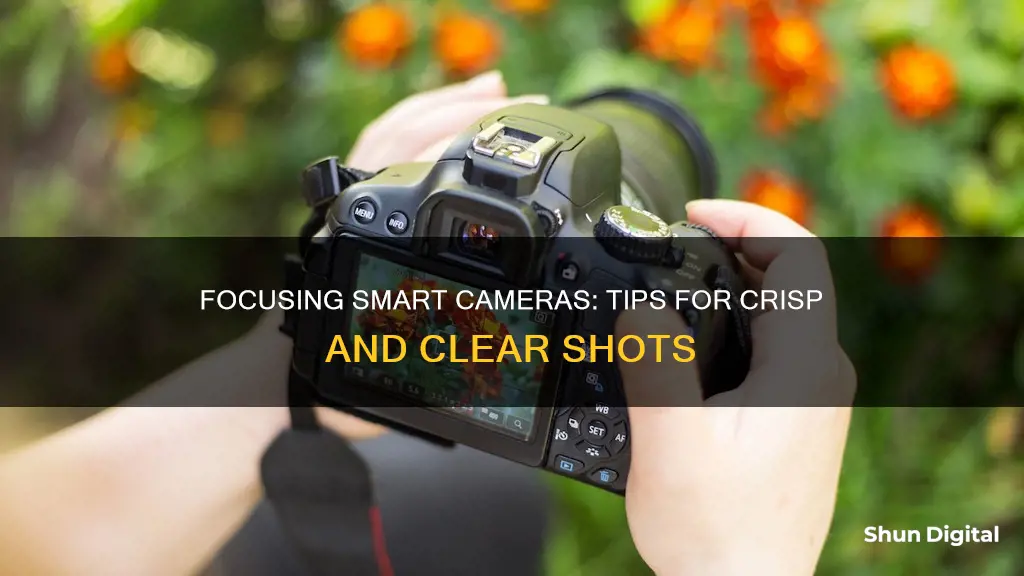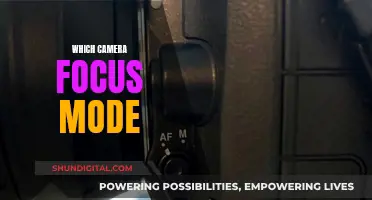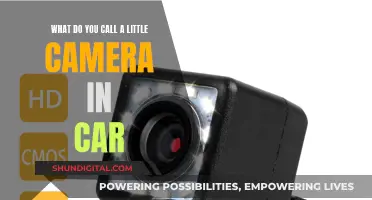
Focusing is a crucial aspect of photography, as it determines the clarity and sharpness of an image. The focus can be adjusted manually or automatically, with modern cameras offering autofocus systems that use motors to adjust the lens elements. Smartphones, being a type of camera, also have autofocus capabilities, and understanding how to use them effectively is essential for capturing high-quality images.
| Characteristics | Values |
|---|---|
| F-stop | F-number, aperture size |
| Purpose | Control the amount of light that passes through the lens at a given shutter speed |
| Aperture | Hole in the camera lens that lets light pass through |
| Aperture Blades | Form a small hole, almost circular in shape, and can open and close to change the size of the aperture |
| Depth of Field | Control of depth of field is the primary function of the aperture or f-stop setting |
| Focal Length | The "f" in f-stop stands for "focal length" |
What You'll Learn

Manual vs autofocus
Autofocus and manual focus are two different modes of focusing available on modern cameras. Each has its own advantages and disadvantages, and the choice between the two depends on the photographer's needs and shooting conditions.
Autofocus
Autofocus (AF) allows the camera to set the focal point and handle most of the work in ensuring a clear shot. It is generally a quick process, although its speed varies depending on the camera and lens type. Sports-oriented equipment, for example, is typically much faster. Autofocus has seen advancements such as tracking, which enable it to lock focus on a subject and track it through the frame. This feature is particularly useful for capturing moving subjects.
Autofocus systems rely on contrast to identify objects. When this contrast is not present, such as in situations with heavy backlight, the ability of the AF system to focus is severely impeded. Autofocus systems also depend on light to determine where to focus, so they perform poorly in low-light conditions. They can also get confused by scenes with many objects, as they tend to focus on foreground objects.
Manual Focus
Manual focus enables the user to set the focal point, providing more creative control over the image. It offers greater creative control as the user determines the focus point. This method is ideal for situations where autofocus may struggle, such as low-light conditions or taking shots through glass or fences. It is also useful for macro photography, where the focus needs to be precise, and for landscape photography, where the hyperfocal distance needs to be carefully set.
Manual focus is generally slower than autofocus, making it less suitable for capturing moving objects or fast-paced action. It requires the photographer to choose the point of focus, which can be challenging when shooting from the hip or in other situations where the photographer cannot easily see the subject.
In conclusion, neither autofocus nor manual focus is universally superior. Autofocus is generally recommended as the default option, with manual focus being used in specific scenarios where autofocus struggles. such as macro photography, deep landscape photography, complex focus bracketing, scenes with many distracting foreground elements, low-light conditions, or when a precise point of focus is required.
Focus Points: The Key to Camera Precision and Quality
You may want to see also

Phase detection vs contrast detection
Modern digital cameras use one of two autofocus systems: phase detection autofocus or contrast detection autofocus. Both have their pros and cons, and some cameras use a combination of the two.
Phase Detection Autofocus
Phase-detection autofocus (PDAF) is a fast form of autofocus. It relies more on software and algorithms than on mechanically adjusting the lens position. PDAF uses a small number of pixels on a sensor that are set aside and embedded with a phase detection photodiode. These special pixels are scattered across the sensor and receive light from opposite sides of the lens. Using data from all the phase-detecting pixels, the PDAF algorithm determines if the image is in focus. If the light waves gathered from the photodiodes match, then the picture is in focus. If not, the photodiodes determine the correct position of the lens to produce a sharp image.
Phase detection autofocus is much faster than contrast-detection autofocus, making it ideal for moving subjects. However, it does not perform as well in low-light conditions, as it relies on the light coming in through the lens. It also doesn't work in Live View or movie mode, as the camera's mirror blocks the light to the autofocus unit.
Contrast Detection Autofocus
Contrast-detection autofocus (CDAF) is the oldest and most popular method of autofocus found in smartphone cameras. It relies on using the contrast between light and dark areas in a scene to bring the picture into focus. CDAF uses a trial-and-error method, moving the focus motor back and forth in search of the highest contrast between the pixels.
While CDAF does a decent job of passively focusing an image without the need for additional hardware, it is the slowest of all the autofocus systems. It also struggles in low-light conditions and with moving subjects, as the contrast information will change.
Hybrid Autofocus
Some cameras use a combination of phase and contrast detection focusing. These hybrid autofocus systems typically start with phase-detection autofocus to quickly focus the subject, then switch to contrast detection to refine the edges, resulting in the sharpest possible image.
Fight Traffic Tickets: Camera Evidence in Illinois
You may want to see also

Continuous vs single-servo autofocus
Continuous autofocus (known as AI Servo AF on Canon cameras, Continuous AF on Nikons, and Sony Continuous AF on Sony cameras) is designed for shooting moving subjects. In this mode, the camera tracks the subject's movement and adjusts the focus accordingly. It does this by continually checking the distance between the camera and the subject and making adjustments until the shutter is released.
Continuous autofocus is predictive, attempting to calculate where the subject will be when the shutter is released. This helps to reduce errors and counter shutter lag. However, it has limitations when it comes to unpredictable movement.
Single-servo autofocus (known as One Shot AF on Canon cameras, Single-Shot AF on Sonys, and AF-S on Nikons) is best used for static subjects that are not in motion. When the shutter button is half-pressed, the autofocus is activated and, once complete, the focus is locked. If the photographer keeps their finger on the button, no adjustments are made, even if the shot is recomposed.
Single-servo autofocus will not let you release the shutter if the subject is not in focus, whereas continuous autofocus will.
Are Batteries Included? Camera Shopping Basics
You may want to see also

Autofocus area modes
Single-Point AF Area Mode
Single-Point AF Area Mode is a straightforward method where you select a single focus point, typically by using the multi-selector button. This mode is ideal for static compositions when your subject isn't moving faster than you can track through the viewfinder. It provides precise control over the area of focus, making it a good choice for portraits or images where the exact focus point is critical.
Dynamic AF Area Mode
Dynamic AF Area Mode is a versatile tool that allows you to manually select an initial focus point. Once focus is acquired, if your subject moves, the camera will utilise the surrounding focus points to maintain focus. You can usually adjust the number of surrounding points used, making it adaptable to different scenarios. This mode is well-suited for sports, wildlife, and action photography where subjects are in motion but you still want precise control over the initial focus point.
Auto-Area AF Mode
Auto-Area AF Mode is a fully automatic mode where the camera takes charge of selecting the focus points. It relies on various factors, such as subject distances, motion, and even eye detection, to determine the most important elements in the scene. While this mode excels at quickly focusing on nearby subjects, it offers less user control and may not always prioritise the desired subject.
Group AF Area Mode
Group AF Area Mode strikes a balance between Single-Point and Auto-Area modes. It allows you to select a specific autofocus area with a small number of autofocus points, ensuring more precise control than Auto-Area mode. This mode is useful for wildlife, sports, and group portrait photography where you want to focus on a particular subject or group within the frame.
Pinpoint AF Mode
Pinpoint AF Mode is a highly precise mode found on some cameras, such as certain Nikon models. It utilises contrast detection autofocus to focus on a very small portion of the scene. This mode is ideal for stationary subjects like landscapes, architecture, product photography, and macro shots, where precise focus on a specific area is crucial.
3D-Tracking Mode
3D-Tracking Mode is an advanced autofocus area mode that uses subject-to-camera distance measurement and predictive focus tracking. It can anticipate where a moving subject will be when the shutter is released and lock focus accordingly. Additionally, it can use colour recognition to track subjects, making it effective for erratic or unpredictable movements. This mode is well-suited for scenarios like sports or wildlife photography, where subjects move rapidly and unpredictably.
How to Find the Mode Button on the S7 Camera
You may want to see also

Back-button focusing
By default, the shutter release button is used to focus and capture an image. When you half-press the shutter release button, the focus system activates and attempts to focus on the subject. Applying additional pressure captures the image. This means that the single shutter release button serves two purposes: focusing and taking a picture. This can lead to accidentally capturing unwanted images if you apply more pressure than intended.
One of the key advantages of back-button focusing is the ability to shoot in AI-Servo/Continuous Servo (AF-C) mode while retaining the benefits of One-Shot/Single Servo (AF-S). Since the dedicated focusing button is only active when you need to focus, you can keep your finger off it while locking the focus and taking consecutive pictures. This is especially useful when transitioning from shooting a stationary subject to one that is moving.
Additionally, back-button focusing provides instant manual focus control. Since the camera's autofocus is only engaged when you press the dedicated focus button, you can take full control of the manual focus without the camera overriding it when the shutter is released. This is beneficial in situations where your subject is heavily obstructed by objects that hinder the autofocus system.
However, one drawback of back-button focusing is that it requires excellent coordination to operate smoothly. It may take some time and practice to master the technique, especially in challenging shooting conditions or when using a heavy lens.
To set up back-button focusing, you need to access the Custom Functions or Custom Settings Menu on your camera. The specific steps vary depending on the camera model and brand, such as Canon, Nikon, Sony, or Fujifilm. You will need to reassign the autofocus function to a different button and ensure that the shutter button is set to "metering start" or "metering and AF start," depending on the camera model.
How Camera Tickets Affect Your Credit Score
You may want to see also
Frequently asked questions
Autofocus (AF) is a feature that allows digital cameras and smartphones to automatically sharpen the image and focus on a specific spot or subject with little to no input from the user. It is important because it allows you to capture the full amount of detail in your photos.
Autofocus systems use a motor in the camera or lens to focus on a subject you've selected manually or automatically. There are two main types of autofocus systems: phase detection and contrast detection. Phase detection is faster and better at tracking moving subjects, while contrast detection is more precise and better suited for non-moving subjects.
There are currently three different methods for performing autofocus on a smartphone: contrast-detection autofocus, phase-detection autofocus, and laser autofocus. Contrast-detection autofocus is the most common method, while phase-detection and laser autofocus are newer and faster alternatives.
Contrast-detection autofocus is slow and doesn't work well in low-light conditions or for tracking moving objects. Phase-detection autofocus is faster and more accurate, but it is only available on high-end smartphones. Laser autofocus is super-fast and works in low-light conditions, but it is expensive, has limited range, and can be confused by reflections.







